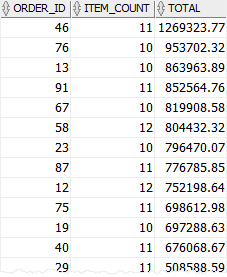You could also use the SUM function to return the name of the department and the total sales (in the associated department). The HAVING clause is applied to each group of the grouped table, much as a WHERE clause is applied to a select list. If there is no GROUP BY clause, the HAVING clause is applied to the entire result as a single group.
The SELECT clause cannot refer directly to any column. Then, the HAVING clause filters all orders whose values are less than or equal to 00000. You can use a complex filter condition in the HAVING clause to filter groups.
Der SQL Befehl HAVING kann man als WHERE des GROUP BY bezeichnen. HAVING folgt immer dem GROUP BY, kann also nicht davor stehen. Mit HAVING kann man die Ausgabe auf. Oracle GROUP BY HAVING. In diesem PostgreSQL-Lernprogramm wird die Verwendung der PostgreSQL-Klausel HAVING mit Syntax und Beispielen erläutert.

Die PostgreSQL HAVING-Klausel wird in Kombination mit der GROUP BY-Klausel verwendet, um die Gruppen der zurückgegebenen Zeilen auf diejenigen zu beschränken, deren Bedingung TRUE ist. HAVING is used to perform an action on groups created by GROUP BY similar to that of the WHERE clause on rows in a basic SQL statement. The WHERE clause limits the rows evaluated.
ORACLE -BASE - SQL for Beginners (Part 7) : The GROUP BY Clause and HAVING Clause. You would have to wrap the query to achieve what you want e. Aggregate Functions. HAVING ) スポンサード リンク グループ単位の集計から条件指定でレコードを抽出するには HAVING を使用する. This shows how we can use the HAVING clause with a SUM function and multiple columns. The SQL GROUP BY clause has more to it than just specifying columns to group by.
There are several different grouping options you can use, and one of them is ROLLUP. The WITH clause may be processed as an inline view or resolved as a temporary table. The advantage of the latter is that repeated references to the subquery may be more efficient as the data is easily retrieved. Wer sich also unschlüssig ist, welche Spalte bei HAVING anzugeben ist, der muss lediglich in die GROUP BY-Klausel schauen, denn genau diese Spalte und keine andere, muss auch bei HAVING stehen.
Alles andere führt zu einer Fehlermeldung. Ein genaues Beispiel zu dieser Problematik findet man im nachfolgenden Video Tutorial. This role contains most database system privileges. Therefore, the DBA role should be granted onl.
It follows the GROUP_BY clause in the SELECT statement. All grouping is performed (and group functions executed) prior to evaluating the. I know the HAVING clause is applied after the groupings are done, but what possible reason could one have to put the join statements in the HAVING clause? Hope my question is clear.
Using an or operator in having clause. Thanks TOM, I know it might be wrong. I understand it might be wrong. I am learning and working too. Please help me modify this.
I was not getting a way to solve this query having OR conditions with EXIST. Sortierungsattribut: nach ORDER BY werden Attribute angegeben, nach denen sortiert werden soll. Die Standardvoreinstellung ist ASC, das bedeutet aufsteigende Sortierung, DESC. Often I see that people tend to reinvent the feature provided by analytic functions by native join and sub-query SQL. Based on that familiarity, it builds the concept of analytic functions through a series of examples.
Let’s start by setting up a sample table for the demonstration.
Keine Kommentare:
Kommentar veröffentlichen
Hinweis: Nur ein Mitglied dieses Blogs kann Kommentare posten.